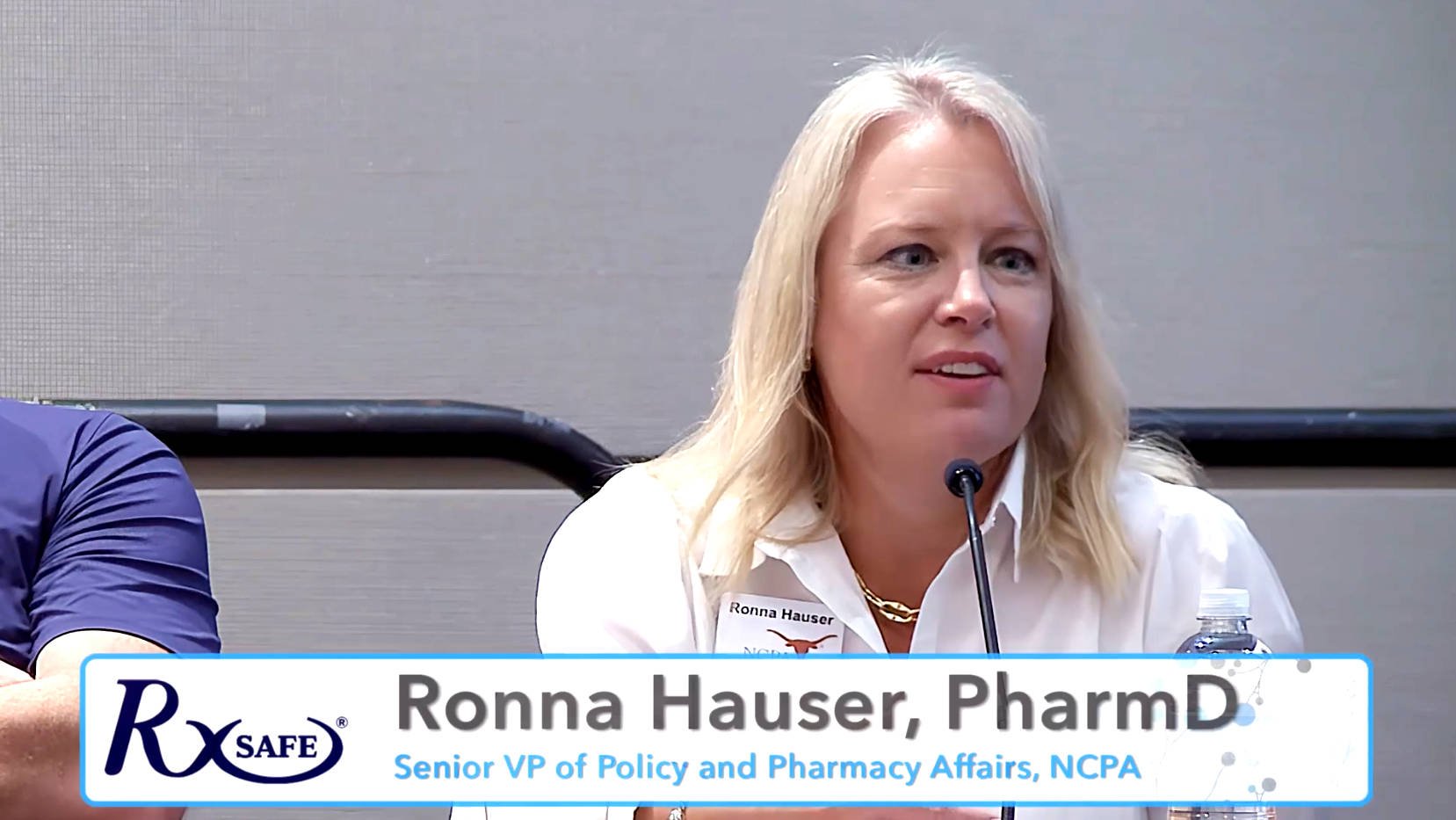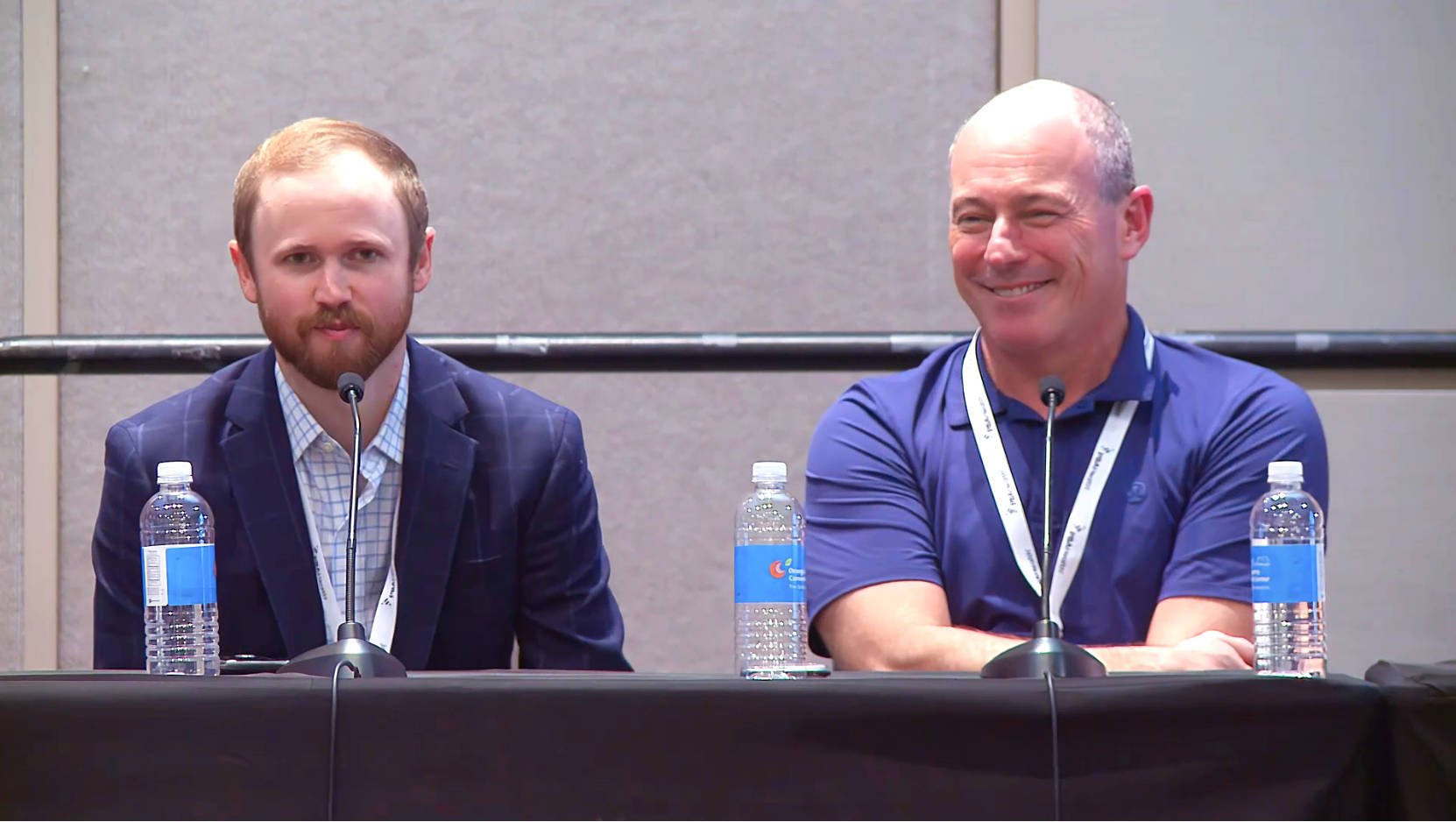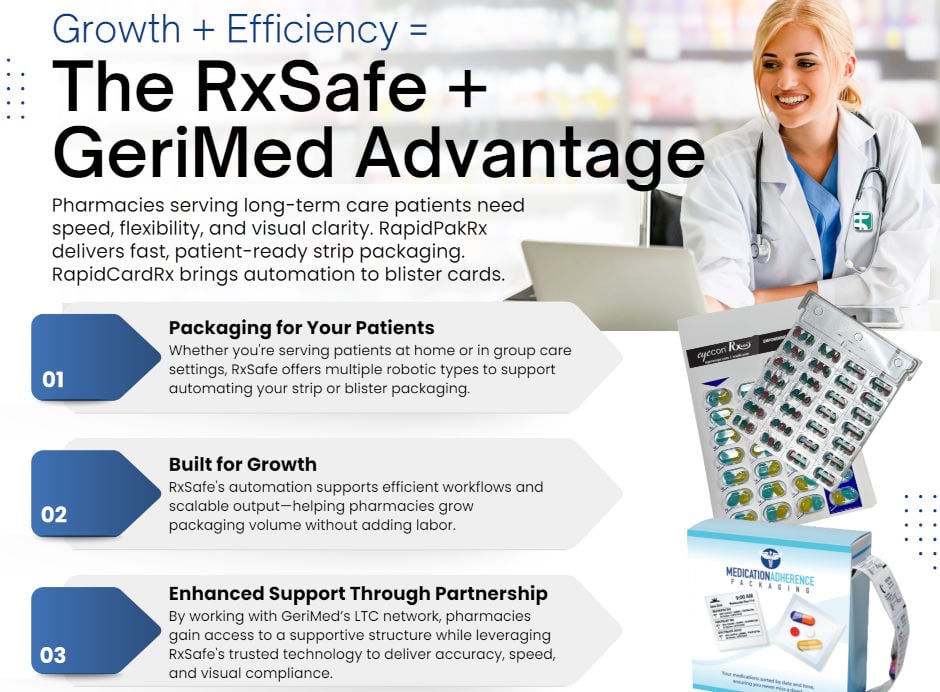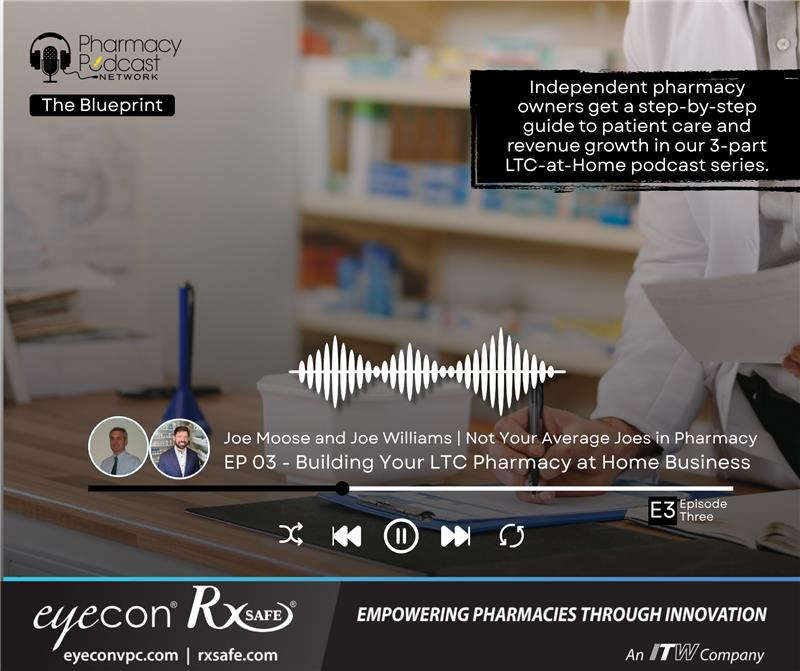At the NCPA conference recently, RxSafe hosted a special panel: "Elevate Your Pharmacy: Profit Boosters & DIR Defense Tactics." Below are a few “best of” highlights from our expert panelists, who discussed, among other things, how to avoid paying DIR fees in 2024, how to tap into LTC-at-home opportunities to boost profit, and how pharmacies take advantage of write-offs before year-end.
Our panelists included:
- Debbie Marcello, RN, CEO of Happier at Home
- Thomas McDowell, PharmD, Pharmacist and Owner, McDowell’s Pharmacy
- Tim Mitchell, RPh, Pharmacist and Owner, Mitchell’s Pharmacy
- Ronna Hauser, SVP at National Community Pharmacists Association (NCPA)
- Lisa Faast, PharmD, CEO, DiversifyRx
- Scotty Sykes, CPA, Sykes & Company
- Todd Eury, Publisher, Pharmacy Podcast Network (Moderator)
 The DIR Defence Tactics special panel at the 2023 NCPA conference featured (from left to right) Debbie Marcelo, Thomas McDowell, Tim Mitchell, Ronna Hauser, Lisa Faast, and Scotty Sykes.
The DIR Defence Tactics special panel at the 2023 NCPA conference featured (from left to right) Debbie Marcelo, Thomas McDowell, Tim Mitchell, Ronna Hauser, Lisa Faast, and Scotty Sykes.
Reducing direct and indirect remuneration (DIR) fees with LTC-at-home services
Debbie Marcello: I'm the CEO and founder of Happier At Home. I'm a registered nurse and have been in home care for probably 30 years. What I'm doing for independent pharmacy owners is giving them a way to be able to expand into the community, expanding services with a private pay source of revenue, which doesn't go through insurances. So what you would be doing is becoming a Happier at Home business owner or franchise and you would provide the services to [00:02:30] help your customers, the community to be able to remain in their homes and independent.
Todd Eury: Thomas McDowell, owner of McDowell's Pharmacy is also a franchise owner of Happier At Home. Thomas, tell us about implementation in the fusion of community pharmacy services with home care services.
Thomas McDowell: We're able to try to keep our patients adherent from the pharmacy, but we don't always know for sure that they're taking the medication. So we felt like Happier at Home was an extension of what we're already doing in the home care space. And if you're keeping up with some of the major players in the industry, they're all kind of shifting towards care in the home with Caremark buying Signify Health, diving into primary care, and Humana bought Kindred Home Care. And so we want to be a part of that journey, that healthcare journey beyond the pharmacy. We already have a captive audience and we're a trusted resource and we already have that relationship with our patients. So we're able to be an extension into the home and provide home care services and we’re really looking at it as a feeder from both sides. We can get new home care clients and tell them about our adherence packaging program, and vice versa. So we're really excited about connecting those two parts of our business, and going beyond just dispensing,
Todd Eury: You're describing a tactic to take control and generate new revenues that have nothing to do with prescriptions. You’re able to think: “What else can this provide? What else can this be used as a marketing source for communications to your community about what you're doing for your community?”
Let’s talk about DIR fees and other tactics to avoid them. So let's go to Tim Mitchell and really understand more. Tim, what tactics have you used to successfully reduce your DIR fees?
Tim Mitchell: There's a lot of different things that we're looking at in our community, that aren’t “traditional pharmacy.” We actually just recently opened up a cost-plus pharmacy, which does not deal with any insurance companies. I actually have also been talking with Debbie for the last couple of years about possibly moving with a franchise with her. But one of our biggest things is moving to what used to be called Medical at Home. Now we're calling it Long Term Care (LTC) at home. It is actually opened my eyes dramatically, and if any of you are not doing that, I highly advise you to find out how you can do that right now. The LTC-at-home has, I was actually just telling Thomas, we mitigated over six figures in DIR fees for this year. So if that doesn't get your attention, then I don't know what will, because that's what's kept us open this year.
Definition and Criteria for LTC-at-Home
Todd Eury: I want to talk more about medical at home. Ronna, you've been our source of information for this for years through NCPA. Talk to us about medical at home and LTC-at-home.
 Ronna Hauser of the NCPA explains the criteria for qualifying LTC-at-Home patients.
Ronna Hauser of the NCPA explains the criteria for qualifying LTC-at-Home patients.
Ronna Hauser: We have pivoted in our name for what this is, starting in 2019 the NCPA's Long-term care division made this our Number One priority: to get the US Centers for Medicare & Medicaid Services (CMS) to recognize long-term care medical at home pharmacy services. And in 2021 they did, which is actually quick when you're working with the government and CMS to get them to put something out in two years. They put a memo out that said they realize there's a higher level of pharmacy care that can be provided to a patient residing in their home, who otherwise would be in a facility. So that was Phase One. Now Phase Two is actually, besides just a memo, recognizing the service. We want a regulation that mandates payment for the service. So that's our next phase. And NCPA has joined forces with the American Society of Consultant Pharmacists and the Senior Care Pharmacy Coalition and a group that includes the long-term care GPOs. It includes several long-term care pharmacy owners. So we formed the alliance for LTC at home, so hence Tim's reference. We've moved from medical at home to a “LTC-at-home moniker here, and www.pharmacyathome.org is the website for the alliance.
Ronna Hauser: We've made great inroads in a fairly short time. We formally formed the Alliance a year ago. If you go to that website, we have criteria on there. We've worked as an industry to define what this is:
- 3+ chronic conditions;
- 6+ six plus meds;
- limited mobility;
- assistance with 2+ activities of daily living.
Ronna Hauser: So we've defined what the services are and they're mainly a playbook off the long-term care pharmacy services provided to Medicare Part D patients. And then we've talked about what patients would qualify for these services. Again, these are folks that would otherwise be in a facility, but choose to age in home. So we made great strides in a short amount of time and having a lot of conversations with this administration. This current administration led by President Biden is very focused on ways to allow patients to age at home. So there's been a lot of interest in what we're talking about. And our focus is to get CMS again to recognize these services which they've done, but take it one step further and require a higher level of payment for these services for Part D patients.
Year-End Tax Planning
Todd Eury: I want to go to Scotty and talk about optimizing and tax planning because when we're talking about new revenues, something that I'm at fault in my small business, instead of looking at what I could do with my status quo and improving taxes for myself, I'm always looking at how do I grow, grow, grow, grow. But if we take a pause and think of where we're at in tax planning, which is a very important part of owning a business, but I wanted to turn it over to Scotty.
Scotty Sykes: Yeah, the IRS is your silent partner whether you like it or not. So you should absolutely be planning for taxes. With tax rates of 30% to 40%, that can add up to a lot of money, a lot of cashflow. You need to be making moves right now in terms of tax planning and planning ahead for that. So you're not getting that call on April 15th saying, oh yeah, I need to write a $100,000 hundred check. So you want to be getting ahead of that. Implement strategies now because a lot of things you can do now, retirement planning, I mean a whole list of things you can't really do after the end of the year. You have to get ahead of that. And to be able to get ahead of that, you have to have fundamental accounting in your pharmacy.
Anybody that's listened to us talk, we strongly believe that fundamental accounting is crucial for a pharmacy. And that begins with the balance sheet, making sure that balance sheet's tied down. And once you have that fundamental accounting, not only will you hopefully be able to plan and prepare for taxes, which we're doing right now across our firm, you're going to understand your cashflow better as well. You're going to know your margins. You're going to know those KPIs. You're going to know that bottom line. You're going to know why your bottom line doesn't mean your bank account balance, and you'll be able to follow the cashflow in your pharmacy. It's a little different in every pharmacy, but you'll be able to understand and follow your cashflow. And that's critical going into the 2024 DIR fee cliff that we're facing here. And you’ve just got to have it. So that's step one. In my opinion, you have to have those fundamental accounting numbers in place.
Fee Mitigation with Adherence Packaging
Todd Eury: Thank you, Scotty. Okay, let's think about growth. And when I think about LTC-at-home, there is a significant opportunity for our community pharmacies who right now, and those doing home care services right now. So Thomas, when I think of extension into the community about home care and the needs of the community that you're in, I think of your model, I think of what you've done with PakMyMeds program, and being able to grow from that. But now you've added on an additional service. So let's talk about the combination of PakMyMeds through RxSafe and adherence packaging and the advantage that you're now going to start building with your home care services.
 Independent pharmacy owners Thomas McDowell (left) and Tim Mitchell (right) discuss how to leverage adherence packaging services and how to save money by offering home patient care.
Independent pharmacy owners Thomas McDowell (left) and Tim Mitchell (right) discuss how to leverage adherence packaging services and how to save money by offering home patient care.
Thomas McDowell: So when we started looking into the medical home or LTC-at-home model, I saw some opportunity, for once, with dispensing. Because before it was just negativity, losing money, trying to mitigate DIR fees, and then there was some light at the end of that tunnel in it. And NCPA has been doing a ton of work to try to promote that and get all the payers to recognize it, get CMS to recognize it and kind of force the payers to recognize that higher level of service, which they should because there's value there in helping keep the patient at home, which lowers costs. And so we have really tried to go “all in” on that, and I see that as being a model for most community pharmacies, because most of us are doing adherence packaging and most of us do delivery. And that's the two biggest checkoffs as far as infrastructure to get started on the long-term care at home side.
Thomas McDowell: And after that, it’s just understanding how to qualify them and the requirements. And on the Happier At Home care side, we saw an opportunity to feed into the long-term care at home billing and to provide an extra layer of service on the home care side that differentiates us from other home care companies in our area, because none of them are run by a pharmacist and none of them can provide adherence packaging and free home delivery like that in a very seamless manner. So we're really working on cohesion between the two companies and rolling out those services to everybody in the pharmacy and everybody on the home care side so that they can become patients for both businesses and get a higher level of care from both sides than they would otherwise; that is the goal.
Todd Eury: Tim, I enjoy your success stories of leveraging adherence packaging, and I want you to share with our crowd today what you've done and how you've grown your business and how you're extending it.
Tim Mitchell: So how we started: first, I purchased the RapidPakRx machine back when there was an announcement of a pandemic occurring. And my staff all freaked out when I purchased a piece of equipment that they had to learn how to use. But now they all love it. And I will tell you, we grew the number of patients and then when we realized that we could use that as a tool to be able to move into the long-term care at home, we actually took most of those patients that were very complicated patients and automatically converted them over because they all qualified. So we immediately had, I think 200-some-odd patients. Now we're up to close to 400 patients that we take care of every month. We have community health workers in our pharmacy that are also our pharmacy technicians that go over their medication list, go over their social determinants of health, a lot of different things.
Tim Mitchell: But as I said earlier, I wouldn't be able to continue doing the types of things I'm doing if I hadn't purchased that machine to help me get this across the line. So I really do feel like that saved our business for this year. I consider myself a fairly innovative person, but I really didn't foresee us being able to do it. I just thought that was another service that we could offer. But it actually has created a much better opportunity for us to be able to offer these long-term care services. We're doing other things, but that is one of the big things that I wanted to make sure everybody understood about my particular practice and how it's saved our practice.
-------------------- (end of NCPA highlights)--------------------
Thanks for reading our “highlight reel” from the conference session. If you’d like to watch the entire recording, click here. Below are more time-stamps of some other Q&A with the NCPA attendees and panelists.
8:57 – Dr. Lisa Faast discusses DIR fee changes in 2024 and how it will affect cash flow; offering cash-based services
11:00 – Q&A on filling scripts while losing money
22:45 – How to find patients for LTC if you are just starting out; how to qualify patients
29:08 - Tapping into the LTC-at-Home market; more on Happier at Home and aging in place
33:57 – Expanding pharmacy services to shore up cash flow
36:04 – Tax benefits for community pharmacy explained; How much can you write-off?
41:18 – Expanding your business with automation and offering supplements
46:59 - How community healthcare workers (CHWs) expand the reach of pharmacy techs and patient access
49:05 – Filling LTC-at-Home prescriptions at the pharmacy
50:08 - LTC patient policies and adherence packaging
51:38 - What Part B Plans recognize payments?


.png)




.png)


